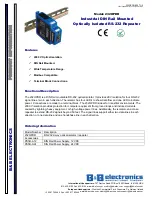
3
ANNUAL (before heating season)
1. ELECTRICAL
Check all terminal connections and conductors.
Tighten loose connections. Conductors with damaged
insulation must be replaced.
Inspect contactor contacts.
If badly pitted, burned or welded shut, replace with factory supplied contactor. For
severe duty conditions such as arctic duty or drilling rigs, CCI Thermal recommends the contactor be replaced
every two years.
Check fuses.
Fuse rating and type are on printed circuit board. Correct fuse must be in the active fuse clip. It is
recommended that a spare fuse be stored in the spare fuse clip.
Check all explosion-proof conduits.
Replace damaged conduits. All threaded conduit connections must have
a minimum 5 turns engagement. Straight threaded conduit must protrude a minimum of 1/16” (1.6mm) inside
enclosures. Taper threaded connections must be at least hand tight.
Check electrical resistance on all load side legs.
Reading should be balanced (± 5%).
2. MECHANICAL
Check for fluid leakage.
The heater core is vacuum charged and contains propylene glycol. Inspect the
Pressure Relief Valve label indicator for signs of rupture and degradation. If the paper is torn, disintegrated or
otherwise compromised this is an indication that fluid has leaked from the core. If any fluid leakage occurs from
the heater, disconnect it from the power supply and have the core replaced. A factory supplied exchange core
can be shipped immediately from stock. Refer to the "Repair and Replacement" section for details.
Check all enclosures.
Interior of enclosures must be clean, dry and free of foreign materials. Threaded covers
must be installed and hand tight.
Note: Enclosure joints are metal to metal. Do not use gasket material or sealant in joints. A grease is applied to
the joints at the factory and should be left intact.
Check motor shaft bearing play.
Replace motor if play is excessive, or if motor does not run quietly and
smoothly. Motor bearings are permanently lubricated.
Check fan.
Replace immediately if cracked or damaged.
Check louvers.
Louver screws should be tight. Louvers shall not be fully closed or override stops.
Check the tightness of all hardware.
All nuts and bolts, including mounting hardware, must be tight.
Turn heater on for a minimum of five minutes.
Check for warm air exiting heater through louvers. Crackling or
pinging noises within heater during start-up are normal.
For assistance, please call
Toll Free: 1-800-661-8529 (24 hrs)
U.S. & Canada
PERIODIC (before and as required during heating season)
1. CLEAN
�
Finned Tubes
2. CHECK
�
Motor for smooth, quiet operation
�
Fan
�
Louvers for proper angle and tightness
�
Fan Guard
�
All explosion-proof covers for tightness
�
Motor
�
Pressure relief device for signs of
�
Louvers
leakage. See Figure 1 and refer to the
ANNUAL Section (see below) item 2 for
further instructions
Remove dust using compressed air. Do not spray with water or solvents.
Do not immerse in water or solvents.



































